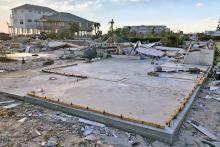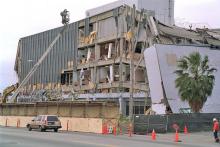Building Science Resource Library
The Building Science Resource Library contains all of FEMA’s hazard-specific guidance that focuses on creating hazard-resistant communities.
You can search for a document by its title, or filter the collection to browse by:
- Topic: High winds, flood, earthquake, etc.
- Document Type: Brochure, report, fact sheet, infographic, etc.
- Audience: Building professionals & engineers, individuals & homeowners, teachers & kids, etc.

Sign up for the building science newsletter to stay up to date on new resources, events and more. Don't forget to confirm your subscription in the follow-up email.
This storybook for children in grades 3-6 relates the adventures of the safety-conscious mayor of Shakeyville (Terry the Turtle) and a group of safety volunteers who meet with students at the local elementary school to teach them about earthquake safety. The students discover the importance of earthquake safety and preparedness. Included are suggestions for creating a disaster kit, illustrations of what to do if an earthquake happens (Drop, Cover, and Hold), and a list of resources.
The FEMA National Earthquake Hazards Reduction Program: Accomplishments in Fiscal Year 2013
fema_earthquakes_fema-national-earthquake-hazards-reduction-program-accomplishments-in-fiscal-year-2013
The National Earthquake Hazards Reduction Program (NEHRP), which was first authorized by Congress in 1977, coordinates the earthquake-related activities of the Federal Government. The goal of NEHRP is to mitigate earthquake losses in the United States through basic and directed research and implementation activities in the fields of earthquake science and engineering. Under NEHRP, FEMA is responsible for developing effective earthquake risk reduction tools and promoting their implementation, as well as supporting the development of disaster-resistant building codes and standards. FEMA's NEHRP activities are led by the FEMA Headquarters (HQ), Federal Insurance and Mitigation Administration, Risk Reduction Division, Building Science Branch, in strong partnership with other FEMA HQ Directorates, and in coordination with the FEMA Regions, the States, the earthquake consortia, and other public and private partners. This report describes selected FEMA NEHRP accomplishments (HQ and Regional), followed by highlights from the States and U.S. territories and organizations which received FEMA support for NEHRP activities. The accomplishments described in this report showcase how FEMA and its partners, working in collaboration, continued to make progress toward earthquake loss-reduction nationwide.
New guidance and tools, continued and expanded support by FEMA Regional and Headquarters staff for ShakeOut drills and the 2013 Building Safety Month, training in earthquake topics offered at the State and local level, and best practices and new and innovative projects undertaken by States and U.S. Territories and organizations.
This PowerPoint presentation is based on FEMA 396, Incremental Seismic Rehabilitation of Hospital Buildings: Providing Protection to People and Buildings. Recognizing that seismic mitigation can be expensive and disruptive, the purpose of this workshop is to introduce you to an innovative approach to seismic mitigation called “incremental seismic rehabilitation.” The approach essentially identifies systematic “opportunities” to conduct mitigation activities. Students are introduced to earthquake hazards in health care settings and learn about methods that can be used to analyze and reduce risks of damage in hospitals and other medical buildings. By implementing sound, cost-effective mitigation measures, health care facilities can reduce or eliminate seismic risks and ensure that, in the event of an earthquake, they can remain in operation to serve their communities.
This publication documents the broad range of non-structural mitigation activities undertaken nationwide in communities exposed to coastal flooding and erosion.
A tsunami is one of nature’s most powerful and destructive forces. This fact sheet combines a brief overview of the risks posed by tsunamis with a capsulized explanation of the ways in which communities can address those risks by employing techniques credited under the Community Rating System.
To aid in the reconstruction of the Gulf Coast in the wake of Hurricane Katrina, this manual presents an overview of the principal planning and design considerations for improving the performance of critical facilities during, and in the aftermath of, flooding and high-wind events. It provides design guidance and practical recommendations for protecting critical facilities and their occupants against these natural hazards. The focus is on the design for new construction, but this manual also addresses rehabilitation of existing critical facilities. It presents incremental approaches that can be implemented over time to decrease the vulnerability of buildings, but emphasizes the importance of incorporating the requirements for mitigation against flooding and high winds into the planning and design of critical facilities from the very beginning of the process.




